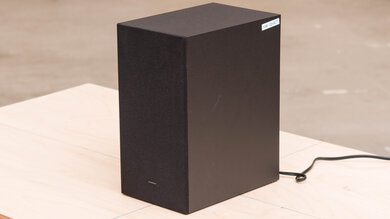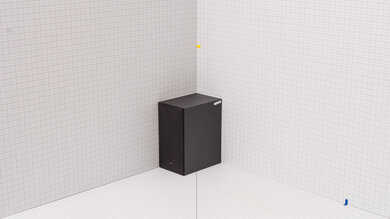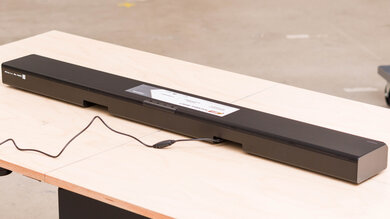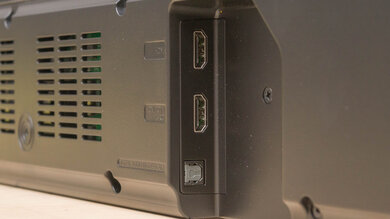The Samsung HW-Q59CT is a 5.1 setup released in 2021. It uses built-in Acoustic Beam technology to more accurately localize sound objects for a more immersive listening experience when using its 'Surround Sound' and 'Game Mode Pro' presets. The manufacturer also says that you can use its Q-Symphony feature with certain Samsung TVs to create a more immersive sound. If you want to listen to music, its 'Standard' preset has a pretty neutral sound profile that's suitable for most types of audio content, but unfortunately, it doesn't support Dolby Atmos content.
Note: The manufacturer advertises this soundbar as a 5.1 setup. However, during our tests, we found that it has a 3.1 setup when using its 'Standard' preset. With its 'Game Mode Pro' and 'Surround Sound' presets, it uses Acoustic Beam technology to simulate a 5.1 setup, which the manufacturer says helps with sound positioning to create a more immersive listening experience.
Our Verdict
The Samsung HW-Q59CT is decent for mixed usage. With its 'Standard' preset, it has a neutral sound profile with a little extra punch in the bass range that's still suitable for most types of audio content. It's well-suited for dialogue-heavy content, thanks to its discrete center channel. You can also use its 'Surround Sound' or 'Game Mode Pro' presets to activate its Acoustic Beam technology for a more immersive surround sound, though these presets aren't ideal for listening to music. Unfortunately, it doesn't support Atmos content.
-
Graphic EQ and presets.
-
Bass and treble adjustments.
-
No Atmos support.
-
Lacks low-bass.
The Samsung HW-Q59CT soundbar is very good for dialogue-centric content like TV shows. Its balanced mid-range can reproduce voices clearly and with detail, and its discrete center channel helps accurately localize dialogue within the sound image. There's even a dialogue enhancement feature to make voices more crisp and clear. While you can wirelessly stream podcasts from your phone to the bar via Bluetooth, unfortunately, it doesn't support Wi-Fi, Apple AirPlay, or Chromecast built-in.
-
Dialogue enhancement mode.
-
Auto-volume mode.
-
No Wi-Fi, Apple AirPlay, or Chromecast built-in support.
The Samsung HW-Q59CT is good for music. With its 'Standard' preset, it has a pretty neutral sound profile with a little extra punch in the bass range. It's suitable for listening to most types of audio content, and you can use the bass and treble adjustments and the graphic EQ to create a different sound if you prefer. Unfortunately, it struggles to reproduce a thumpy low-bass, so it isn't ideal for bass-heavy genres like EDM.
-
Graphic EQ and presets.
-
Bass and treble adjustments.
-
Lacks low-bass.
The Samsung HW-Q59CT is fair for movies. Its balanced mid-range can reproduce voices clearly and with detail, though it struggles to reproduce the deep thump and rumble in action-packed scenes. With its 'Surround Sound' preset, it uses up-firing Acoustic Beam drivers to create a more immersive listening experience. Unfortunately, it doesn't support Dolby Atmos content.
-
Graphic EQ and presets.
-
Bass and treble adjustments.
-
No Atmos support.
-
Lacks low-bass.
- 7.2 Mixed Usage
- 7.9 Dialogue/TV Shows
- 7.5 Music
- 6.6 Movies
- Updated Jul 25, 2023: Added market comparison with the Samsung HW-Q60C in the Height (Atmos) box.
- Updated Feb 21, 2023: Added market comparison with the Samsung HW-Q600B to the Height (Atmos) box.
- Updated Oct 07, 2021: Review published.
- Updated Oct 01, 2021: Early access published.
- Updated Sep 24, 2021: Our testers have started testing this product.
- Updated Sep 17, 2021: The product has arrived in our lab, and our testers will start evaluating it soon.
- Updated Sep 05, 2021: We've purchased the product and are waiting for it to arrive in our lab.
Differences Between Sizes And Variants
The Samsung HW-Q59CT is available in 'Black', and you can see the label for the model we tested here.
If you come across another version of this bar, please let us know in the discussions, and we'll update our review.
Compared To Other Soundbars
The Samsung Q59CT soundbar has a similar design to the Samsung HW-Q60T. Both soundbars are advertised as a 5.1 setup, and they use Acoustic Beam technology to create a more immersive sound with certain EQ presets. Unlike the HW-Q60T, this soundbar also supports Tap Sound, which is advertised to mirror sound from your phone to the bar when tapped against the bar.
See also our recommendations for the best soundbars under $500, the best 5.1 soundbars, and the best Samsung soundbars.
The Samsung HW-Q59CT and the Sonos Beam offer similar overall performances. The Samsung is a 5.1 setup with a dedicated sub reproducing a more extended low-bass. Unlike the Sonos, it has a Full HDMI In port for high-quality passthrough. That said, the 3.0 Sonos is better built, and its more compact design may be ideal for some users. It also has better soundstage and center performances.
The standalone Sonos Arc is better than the Samsung HW-Q59CT. The Sonos is better built and supports Dolby Atmos content. It has better soundstage, surround, and center performances. Unlike the Samsung soundbar, it has room correction and built-in voice assistant support. However, only the Samsung has a graphic EQ and presets for sound customization.
The Samsung HW-Q60C/Q6CC is a more versatile soundbar setup than the Samsung HW-Q59CT. They're both mid-range setups with pretty versatile performances, but the Q60C supports more audio formats. Notably, it can playback Dolby Atmos content, though it has to downmix it into stereo to do so.
The Vizio V Series V51-H6 is better than the Samsung HW-Q59CT. The Vizio has discrete satellites and offers a better surround performance. It can also reproduce a more extended low-bass and can get louder with less compression at max volume. However, the Samsung is better built with a Full HDMI In port for high-quality passthrough.
The Vizio M Series M51a-H6 is better than the Samsung HW-Q59CT. The Vizio comes with discrete satellite speakers, and unlike the Samsung soundbar, it supports Dolby Atmos content. It also offers a better surround performance and can reproduce a more extended low bass. That said, the Samsung is better built, and some listeners may prefer its graphic EQ for sound customization over the Vizio's bass and treble adjustments.
The Vizio M Series M512a-H6 is better than the Samsung HW-Q59CT. The Vizio supports Dolby Atmos content and has better soundstage, center, and surround performances. Unlike the Samsung soundbar, it comes with discrete satellite speakers. It also reproduces a more extended low-bass. However, only the Samsung soundbar has a graphic EQ, which some users may prefer for sound customization.
The Vizio M Series M51ax-J6 is better than the Samsung HW-Q59CT. The Vizio supports Dolby Atmos content and has better center and surround performances. It also reproduces a more extended low bass. However, the Samsung is better built and has a graphic EQ.
The Samsung HW-Q65T is better than the Samsung HW-Q59CT. While both 5.1 setups perform very similarly overall, the HW-Q65T comes with discrete satellite speakers. It offers a better surrounds performance, too.
Depending on your listening habits, you may prefer either the Samsung HW-Q60T or the Samsung HW-Q59CT. The HW-Q60T is better built and has a better surrounds performance. That said, the HW-Q59CT reproduces a slightly more extended low-bass. The manufacturer also says that it supports some more features like TapSound.
The Samsung HW-Q600A is better than the Samsung HW-Q59CT for most uses. The HW-Q600A is a 3.1.2 setup that's better built. Unlike the 5.1 HW-Q59CT, it supports Dolby Atmos content. That said, both bars have a good stereo frequency response and lots of customization options.
The Samsung HW-A650 is marginally better for mixed usage than the Samsung HW-Q59CT. The HW-A650 is better built, and it has better center and surround performances. However, both bars have good stereo frequency responses and lots of customization options.
The Samsung HW-Q59CT is marginally better for mixed usage than the Samsung HW-A550. Both soundbars offer very similar performances overall. However, the 5.1 HW-Q59CT has a discrete center channel, which helps anchor voices to a more accurate location in the soundstage compared to the 2.1 HW-A550's phantom localization.
Depending on your listening habits, you may prefer either the Samsung HW-Q59CT or the Samsung HW-Q600B. The Q59CT is a 5.1 soundbar, meaning that it comes with two additional channels for surround sound. It has a better surrounds performance, naturally. However, it doesn't support height content like Dolby Atmos. If you watch a lot of Atmos content, the Q600B is likely the better choice, even though its advertised up-firing channels didn't work on our unit, and it has to play height content through its side-firing drivers instead.
Test Results
The Samsung HW-Q59CT is a simple soundbar with a similar design to the Samsung HW-Q60T. It's plastic, with a metal grille covering the top and front.
The Samsung HW-Q59CT has a good build quality. The bar is high-quality plastic, and the metal grille covering the front and the top helps protect the drivers inside. Unfortunately, the sub feels a bit cheap. It's mostly made of melamine, and the wood behind the fabric for our model flexes. The fabric covering is also loose, so it seems like it could rip easily.
The Samsung HW-Q59CT has a very good stereo frequency response. On its 'Standard' preset, it has a pretty neutral sound profile with a little extra punch in the bass range that should be suitable for most types of audio content. That said, it struggles to reproduce the deep thump and rumble in the low-bass. However, you can customize its sound to your liking using its graphic EQ and presets.
This soundbar also comes with 'Surround Sound' and 'Game Mode Pro' presets that use Acoustic Beam technology to simulate a 5.1 setup. However, during our subjective listening tests, we found that the 'Standard' preset was better-suited to stereo content, like music. The 'Surround Sound' and 'Game Mode Pro' preset modes tried to push sound higher than the 'Standard' preset, resulting in a more fake and diffused sound with stereo content.
The Samsung HW-Q59CT has a very good stereo frequency response with calibration. With its bass set to '-5' and its treble set to '5', it has a more neutral, balanced sound profile suitable for listening to lots of different types of audio content. Unfortunately, it still doesn't reproduce a very extended low-bass, so you don't feel the low rumble in bass-heavy music or action-packed movies.
The Samsung HW-Q59CT has a decent stereo soundstage. Its soundstage is perceived to be wider than the bar itself, which is good. It also has good focus, so sound objects seem to come from an accurate, pinpoint location rather than a more general area.
The Samsung HW-Q59CT has a very good stereo dynamics performance. It gets loud enough to fill up a large room or a crowded party. While there are some compression artifacts present at max volume, they shouldn't be too noticeable, so audio is still reproduced clearly.
The Samsung HW-Q59CT has a fair THD performance. At normal listening volumes, the THD falls within good limits, so audio reproduction is clean and pure. However, there's a jump in THD when you push the bar to max volume, especially in the bass range. That said, it may not be too noticeable with real-life content.
The Samsung HW-Q59CT has a good center channel performance. Thanks to its 5.1 setup, it has a discrete center channel, which helps to more accurately localize voices to a pinpoint location in the sound image. While its frequency response is a bit bass-heavy, this shouldn't be too noticeable since most voices are reproduced in the mid-range.
The manufacturer advertises the Samsung HW-Q59CT as a 5.1 setup, but during our tests, we found that it has a 3.1 setup with its 'Standard' preset. As a result, it has to downmix surround content into stereo to play it, which doesn't sound as immersive. Audio seems like it's coming from in front of you rather than from speakers placed all around you. The results above reflect our tests with the 'Standard' preset enabled.
However, with its 'Surround Sound' and 'Game Mode Pro' presets, this soundbar uses Acoustic Beam technology to simulate a 5.1 setup. During our subjective listening tests, we found that the 'Surround Sound' preset is better-suited to surround content. It fires sound upward and forward from the bar using a phantom localization, resulting in a more immersive sound. You can see the results for the 'Surround Sound' preset here.
For a bar with support for height content, check out the Samsung HW-Q600B or the Samsung HW-Q60C/Q6CC.
The Samsung HW-Q59CT soundbar has a fair selection of sound enhancement features. You can customize its sound using the bass and treble adjustments as well as its 7-band graphic EQ. It also comes with several EQ presets, including 'Standard', Surround Sound', 'Game Mode Pro', and 'DTS Virtual:X'. Unfortunately, it lacks some more premium sound enhancement features like room correction, so it may sound a bit different depending on the room you're listening in.
The Samsung Q59CT soundbar has several physical inputs. There's a Full HDMI In port, meaning you can use it as a hub between different devices. However, it doesn't have an AUX port, so you can't wire older devices for audio playback.
The Samsung Q59CT soundbar has decent audio format support via ARC. It supports Dolby Digital, which is the most commonly used surround sound format. Also, it supports DTS, which is the fallback for the higher quality DTS-HD MA format.
The Samsung Q59CT soundbar also supports Dolby Digital over its Full HDMI In port, which is handy for listeners who watch a lot of content on Blu-ray discs and streaming services. However, you can't stream object-based or lossless audio formats like Dolby Atmos.
The Samsung Q59CT soundbar also supports Dolby Digital and DTS via Optical in. These formats are commonly found on Blu-ray discs and streaming platforms.
The Samsung Q59CT soundbar has a fair latency performance. It has somewhat high latency via ARC, Optical, and Full HDMI In, so you may notice a bit of delay between the audio you hear and the video you see. As a result, it may not be ideal for watching video over these connections. That said, some apps and TVs compensate for latency differently, so your real-world experience can vary.
The Samsung Q59CT soundbar only lets you stream audio from your mobile devices to the bar wirelessly via Bluetooth.
The Samsung Q59CT soundbar can passthrough high bandwidth signals. When connected between your PC and your TV, text on the screen appears crisp and clear.


















